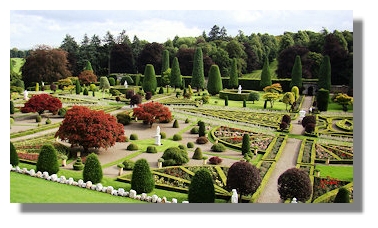Scottie's Diary
- Drummond Castle and Gardens, Perthshire
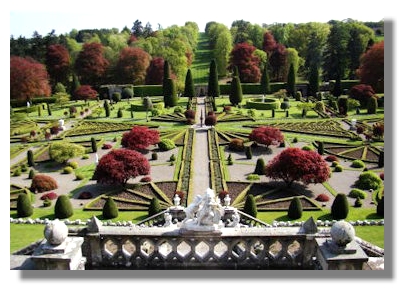
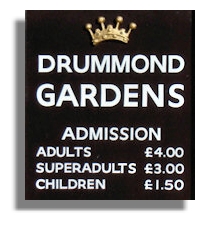
Background
As a member of the National Trust for Scotland and a Friend of Historic Scotland, I get free entry to all their properties. That's great value for money if, like my wife and I, you visit places like Culzean Castle Country park in Ayrshire 18 times a year... Drummond Castle is still privately owned and so we have to pay every time we go there At least we get lower-priced concession tickets or, as Drummond calls us, "Superadults". Even so, it is one of our favourite places to visit, particularly in the late summer and autumn. Read on and you'll see why!
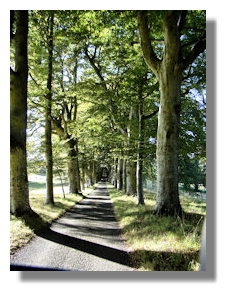
Access
The main access to Drummond Castle is through an imposing gateway on the main A9 road, a little south of Crieff, Perthshire. (You can find it on this map ). The tree-lined driveway then goes on, and on and on.. In fact, the drive is over a mile long with 307 beech trees on each side of the narrow avenue. Originally designed or a horse and carriage, it's actually slightly tight for today's motor cars. The first time I drove along it, I actually started to laugh at the way an early Lord Drummond had chosen to impress his visitors! In fact, The 4th Earl Drummond, a well known agricultural improver at the end of the 17th century, had a plan to grow an avenue of trees all the way from Drummond Castle to Perth - twenty miles away! No local authority planning permissions in those days!
The Castle
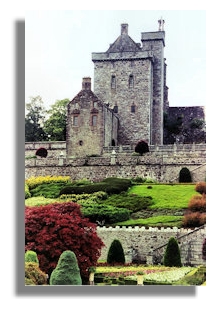
King James IV gave the first Lord Drummond permission to build a stronghold on a rocky outcrop on the edge of Strathearn in 1490. The Drummonds were already a major family in Scotland and that status was to grow over the coming centuries. As was usually the case, the original tower keep was modified and enlarged but the lower floors are those built by the first Lord Drummond. In 1605, King James VI (now king of England as well as Scotland), promoted the 4th Lord Drummond to be the first Earl of Perth. It was the first Earl who is credited with transforming the gardens and castle in the 1630s. The architect, John Mylne III, was King Charles I's master mason.
Cromwell destroyed the keep during the Civil War (it was later rebuilt and a gate house added) but, towards the end of the 17th century, the 4th Earl of Perth built a mansion house, across from the tower, which created an inner courtyard. Visitors cross that to get to an imposing series of steps that go down into the formal gardens far below. There is no public access to the buildings, but there is plenty to see in those gardens!
During the Jacobite Uprisings, the Drummonds supported the Jacobite cause and joined the Earl of Mar in 1715 and Bonnie Prince Charlie in 1745. In order to avoid having government troops billeted in the keep during the '45, the Duchess of Perth had it destroyed. The keep was repaired in 1822.
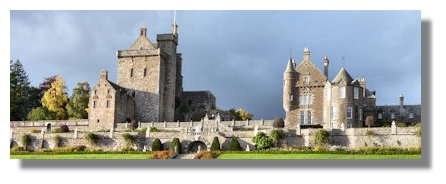
The Gardens
The gardens at Drummond Castle have a long history - there are records of Lord Drummond sending cherries to King James IV in 1508 and there was a substantial formal garden early in the 17th century. The John Mylne obelisk sundial was erected in 1630, showing that there was a large garden at that time. Unlike the more simple versions which show only local time, this sundial has a number of faces on it to give the time in different capitals in the world. It also has a number of verses (in Latin) in which the hours of the day have a "conversation" about the swift passage of time. It begins (in translation):
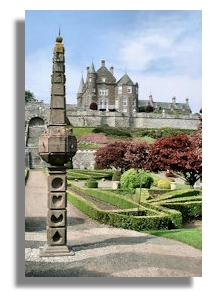
Clearly time flying by is not a modern phenomenon! We are the hours on the pillar you see
Marked by the shadows that ever flee
And move with the sun in its course on high,
Noting the time passing swiftly by.Over the centuries, the garden has been remodelled several times. The 4th Earl employed a gardener, John Reid, who later wrote "The Scots Gard'ner" which was the first Scottish book on the subject (in 1683) It claimed that it was "published for the climate of Scotland".
A later design was laid out in Italian Renaissance style from 1828-1838 and when Queen Victoria and Prince Albert visited the Drummonds in 1842, it was this layout which they saw. It is broadly this plan which is in place today, though with wider range of plant types (thanks to the many Victorian plant hunters).
Vegetable Garden
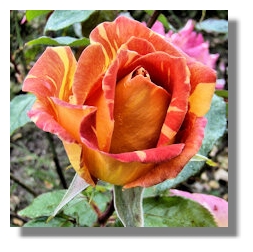
Some visitors may be put off by sign which points to the "Vegetable Garden". But although there are vegetables grown there, this is also where there is an impressive collection of dahlias and roses in the summer and autumn (and, in the spring, apple blossom trained against the surrounding walls).
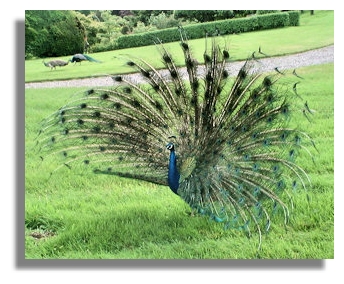
Wild Life As you tour round the gardens, you will often hear the loud call of the peacocks as they strut around (quite oblivious to anyone passing by). There are also plenty of other birds around from Dunnocks to Kestrels. I caught my one and only glimpse of an elusive and brilliantly coloured Kingfisher at Drummond Castle. A black and white cat prowls around keeping the field mice under control and there is a crocodile beside a small pool.. (OK, so it's a sculpture, but at first sight...)
Windows Media Slide Show and Movie
So that I can show a more extensive range of illustrations of what Drummond Castle and its gardens have to offer, I have created another Windows Media Slide Show. This has illustrations showing:
- The tree-lined entrance driveway.
- Drummond Castle.
- An apricot-coloured rose.
- The formal Italian garden.
- Turk's Cap Lily, also known as American Tiger Lily.
- A mass of dahlias.
- The formal Italian garden.
- A peacock.
- Red leaves of an acer.
- Steps up to Drummond Castle.
- A young Dunnock in Pampas Grass.
- Looking up at the mansion house.
- Small Tortoiseshell and Painted Lady butterflies on a red sedum.
- Drummond Castle.
The background music is the Adagio (slow movement) from Mozart's Clarinet Concerto, played by Umesh Shankar.
There is also a series of Video Clips showing the castle from the garden - and the garden from the castle. It runs for about 3½ minutes but if you have a high speed connection it should play smoothly once the buffering has kicked in. The background music is the scherzo from Dvorák's "New World Symphony.
And Finally
For many years, there were no catering facilities at Drummond Castle, which was surprising, given the number of visitors who turn up each day. But there was an easy alternative at an excellent restaurant with lots of home baked cakes just along the road at the Crieff Visitor Centre and another at the Stuart Crystal Factory Shop also on the edge of Crieff. Then in 2008, a mobile catering caravan appeared in the Drummond Castle car park. While the range of food was more limited, it had the benefit of having picnic benches close by.The main access to the gardens is down a steep flight of steps. But for anyone who has problems with that, such as some of those "superadults", there is another car park at the rear of the gardens, providing access for those not sprightly enough to tackle those stairs.
